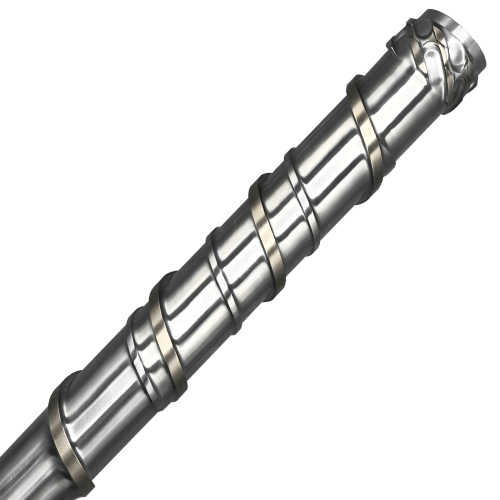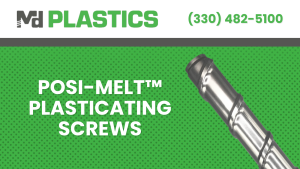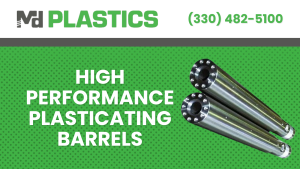In plastics processing, your equipment is the backbone of your business. Every pellet that enters the hopper depends on one thing above all else: consistent, reliable performance from your screws and barrels. Yet too often, these critical components are only addressed when something goes wrong—leading to costly downtime, lost production, and frustrated customers.
At Md Plastics, we believe there’s a better way. With predictive maintenance, processors can move from a reactive “fix it when it breaks” mindset to a proactive strategy that anticipates problems before they occur. Using signals like vibration analysis, melt pressure fluctuations, and other performance data, predictive maintenance keeps your plastic screws and barrels working at peak efficiency while avoiding unnecessary downtime.
Let’s explore why predictive maintenance matters, what signs you should be monitoring, and how you can put it into practice to protect both your equipment and your bottom line.
Why Predictive Maintenance Matters
Screws and barrels are the heart of extrusion and injection molding machines. They take resin from solid pellets to molten material, mix in additives, and deliver it consistently to molds or dies. But they’re also subject to immense stress: high temperatures, abrasive fillers, corrosive chemicals, and mechanical wear.
Traditional maintenance approaches fall into two categories:
- Reactive Maintenance: Wait until something fails, then fix it. This approach results in costly downtime and unpredictable repair schedules.
- Preventive Maintenance: Replace parts at set intervals. While better, it often leads to replacing components too early, increasing costs unnecessarily.
Predictive maintenance offers a smarter alternative. By monitoring equipment signals in real time, processors can identify when components are actually beginning to wear—and act before performance drops or failures occur.
Key Predictive Maintenance Signals
Predictive maintenance relies on measurable signals that indicate the health of screws and barrels. Some of the most important include:
1. Vibration Analysis
Changes in vibration patterns can signal:
- Screw misalignment
- Bearing wear
- Imbalance due to uneven wear or buildup
Regular vibration monitoring helps identify issues early, allowing for corrections before damage spreads.
2. Melt Pressure Fluctuations
Unstable melt pressure is often an early warning sign of screw or barrel wear. Causes may include:
- Worn screw flights reducing pumping efficiency
- Barrel wear creating excess clearance
- Material degradation from poor mixing
Consistent monitoring of melt pressure trends reveals problems before they impact product quality.
3. Melt Temperature Variability
Temperature spikes or inconsistencies can signal:
- Inadequate shear due to worn flights
- Hot spots from material buildup
- Poor mixing efficiency
Stable melt temperature is crucial for consistent part quality. Deviations should never be ignored.
4. Throughput Declines
If your extruder or molding machine is producing less output at the same settings, wear on plastic screws or barrels may be the cause. Reduced efficiency typically indicates increased clearances between screw flights and barrel walls.
5. Visual Inspections
While not “high-tech,” visual inspections remain important. Scoring, scratches, or corrosion inside barrels or on screw flights are clear indicators of wear.
Common Failure Modes in Screws and Barrels
Understanding what causes wear helps processors know what to watch for.
- Abrasive Wear: Fillers like glass fiber grind away at screw flights and barrel walls.
- Corrosive Wear: Certain resins release chemicals that corrode steel.
- Thermal Fatigue: Constant heating and cooling cycles weaken materials over time.
- Mechanical Damage: Foreign objects in the resin stream can gouge screws and barrels.
Predictive maintenance helps catch the effects of these forces before they become catastrophic failures.
Benefits of Predictive Maintenance
The advantages go far beyond just keeping machines running.
- Reduced Downtime – By scheduling repairs or replacements proactively, downtime occurs on your terms—not during peak production.
- Lower Costs – Avoid unnecessary early replacements while still preventing catastrophic failures.
- Improved Product Quality – Stable melt temperatures and pressures mean fewer rejects.
- Energy Savings – Worn screws require more energy to achieve the same results. Healthy equipment means lower power bills.
- Longer Equipment Life – By addressing wear early, predictive maintenance protects barrels, heaters, and other components from collateral damage.
How Predictive Maintenance Works in Practice
A successful predictive maintenance program combines data collection, analysis, and proactive action.
Step 1: Baseline Measurements
Record vibration levels, melt pressure, throughput, and temperature under normal operating conditions. This establishes the “healthy” benchmark.
Step 2: Ongoing Monitoring
Use sensors or manual checks to regularly collect data. Compare results against baseline readings to detect changes.
Step 3: Analysis
Not all fluctuations are cause for alarm. Skilled analysis distinguishes between normal variation and genuine signs of wear.
Step 4: Proactive Action
When trends indicate wear, schedule downtime to replace or repair screws and barrels before catastrophic failure occurs.
Tools and Technology That Help
Modern predictive maintenance relies on both human expertise and advanced tools.
- Vibration Sensors: Mounted on machines to provide real-time vibration data.
- Melt Pressure Transducers: Monitor pressure consistency during operation.
- Infrared Thermography: Detects hot spots in barrels or heaters.
- Digital Throughput Monitoring: Tracks pounds per hour vs. historical averages.
- Software Analytics: Advanced platforms analyze data trends to predict failures with high accuracy.
These tools, combined with operator training and maintenance protocols, create a comprehensive predictive system.
Extending the Life of Plastic Screws and Barrels
Predictive maintenance isn’t just about replacing screws and barrels on time—it’s also about extending their usable life.
1. Material Selection
Choosing screws made of bimetallic alloys or with protective coatings helps resist abrasive or corrosive wear.
2. Proper Startup and Shutdown
Never run machines dry, and always purge appropriately before shutdown to prevent buildup or corrosion.
3. Process Optimization
Avoid excessive screw speeds or unnecessary back pressure, which accelerate wear.
4. Cleaning Practices
Use approved purge compounds and avoid metal tools that can damage surfaces during cleaning.
5. Training and Culture
Operators who understand predictive maintenance are less likely to ignore early warning signs. Building a culture of proactive care is as important as any sensor or tool.
Case Example: Predictive Maintenance in Action
A processor running glass-filled nylon noticed gradual increases in melt pressure variability and energy consumption. Predictive analysis indicated wear on the screw flights and barrel liner. Instead of waiting for a full breakdown, the company scheduled a controlled shutdown for replacement.
Results:
- Downtime reduced from weeks to just 48 hours
- Scrap rates dropped by 18%
- Energy consumption decreased by 12%
This example illustrates the bottom-line benefits of predictive maintenance for plastic screws and barrels.
Why Partnering with a Custom Screw Expert Matters
While predictive maintenance focuses on monitoring, the real payoff comes when you replace worn components with optimized designs. That’s where a knowledgeable partner makes the difference.
At Md Plastics, we combine advanced engineering with decades of industry experience to design and manufacture screws and barrels that not only replace worn parts but enhance your overall process. Our team understands the unique challenges of different resins, from abrasive glass-filled polymers to heat-sensitive bio-based materials, and we create custom solutions that maximize performance and lifespan.
Md Plastics: Your Partner in Process Reliability
As a trusted custom screw manufacturer and engineering partner, Md Plastics offers more than replacement parts—we provide solutions that transform your production. Our services include:
- Custom-Designed Plastic Screws: Engineered for your specific resins and applications.
- Wear-Resistant Materials and Coatings: Extending the life of screws and barrels.
- Process Expertise: Helping you interpret maintenance data and implement predictive strategies.
- Commitment to Quality: Every screw is manufactured to exacting standards, ensuring performance and durability.
When you work with Md Plastics, you gain more than a supplier—you gain a partner dedicated to keeping your equipment reliable and your business profitable.
Building a Future-Proof Maintenance Strategy
The plastics industry is evolving rapidly, with new materials, higher demands for quality, and tighter margins. Waiting for equipment to fail is no longer an option. Predictive maintenance, driven by signals like vibration and melt performance, empowers processors to stay ahead of problems, reduce downtime, and protect their investments.
At Md Plastics, we’re here to help you every step of the way. From designing high-performance plastic screws to providing insights into maintenance best practices, we work side by side with you to build a future-proof operation. If you’re ready to move from reactive firefighting to proactive success, visit Md Plastics to learn how we can support your predictive maintenance strategy. Together, we’ll ensure your screws and barrels stay reliable, your products stay consistent, and your business stays strong.




